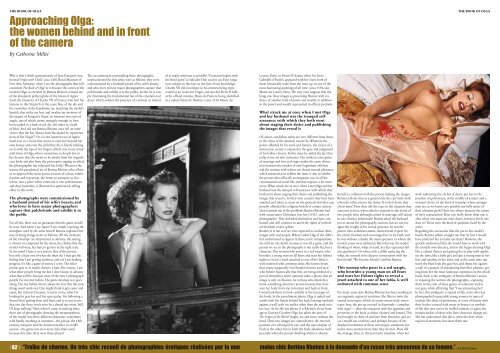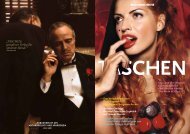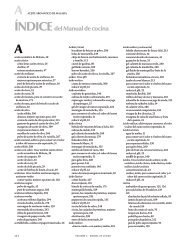“TASCHEN: wonderful publisher of sumptuous tomes.”
“TASCHEN: wonderful publisher of sumptuous tomes.”
“TASCHEN: wonderful publisher of sumptuous tomes.”
Create successful ePaper yourself
Turn your PDF publications into a flip-book with our unique Google optimized e-Paper software.
THE BOOK OF OLGA<br />
Approaching Olga:<br />
the women behind and in front<br />
<strong>of</strong> the camera<br />
By Catherine Millet<br />
Why is that I think spontaneously <strong>of</strong> Jean Fouquet’s marmorean<br />
Virgin with Child (circa 1450, Royal Museum <strong>of</strong><br />
Fine Arts, Antwerp) when I see the photographs that will<br />
constitute The Book <strong>of</strong> Olga? Is it because the curves <strong>of</strong> the<br />
modern Olga, as revealed by Bettina Rheims, remind me<br />
<strong>of</strong> the absolutely perfect globe <strong>of</strong> the breast <strong>of</strong> Agnès<br />
Sorel, the favourite <strong>of</strong> Charles VII <strong>of</strong> France, who lent her<br />
features to this Virgin? Is it the azure blue <strong>of</strong> the sky and<br />
the vermilion <strong>of</strong> the handsome car, matching the model’s<br />
lipstick, that strike me here and awaken my memory <strong>of</strong><br />
the impact <strong>of</strong> Fouquet’s Virgin, set between two rows <strong>of</strong><br />
angels, one <strong>of</strong> which seems, strangely enough, to have<br />
been soaked in a bath <strong>of</strong> red dye, the other in a bath<br />
<strong>of</strong> blue? And did not Bettina Rheims once tell an interviewer<br />
that she has “always been fascinated by representations<br />
<strong>of</strong> the Virgin<strong>”</strong>? Or is it the lowered eyes <strong>of</strong> Agnès<br />
Sorel, lost in a vision that seems to carry her beyond her<br />
own beauty and even the child that she is barely holding<br />
on to with the tips <strong>of</strong> her fingers, which mix in my mind<br />
with those <strong>of</strong> Olga, who is sometimes so deeply lost in<br />
her dreams that she seems to be absent from her magnificent<br />
body and also from the provocative staging to which<br />
the photographer has subjected her body? Whatever the<br />
reason, the paradoxical art <strong>of</strong> Bettina Rheims, who allows<br />
us to approach the most joyous excesses <strong>of</strong> colour, exhibitionism<br />
and voyeurism, the better to transport us elsewhere,<br />
into a place where eroticism is one with humour<br />
and deep humanity, is illustrated to particularly telling<br />
effect in this work.<br />
The photographs were commissioned by<br />
a husband proud <strong>of</strong> his wife’s beauty, and<br />
who loves to have major photographers<br />
capture that pulchritude and exhibit it to<br />
the public<br />
For all this, there was no guarantee that the game would<br />
be won. And when I say “game<strong>”</strong>, I am simply reprising the<br />
metaphor used by the artist herself. Bettina explained her<br />
way <strong>of</strong> doing things to me as follows: “All the elements<br />
<strong>of</strong> the ‘envelope’ are determined in advance, the setting<br />
is chosen or composed for the shots, the clothes that the<br />
model will wear, her hair, to get her in the right state.<br />
In my mind I have a very precise idea <strong>of</strong> the person,<br />
but only a hazy one <strong>of</strong> what she must do. I may get the<br />
feeling that I am getting nowhere, and yet I am making<br />
progress. It’s like a game <strong>of</strong> tennis. I serve. The other<br />
person gets it, or maybe doesn’t. I wait. She returns. I use<br />
what other people bring me but I don’t know in advance<br />
what that will be, because most <strong>of</strong> the time I photograph<br />
people I’ve not met before. The game develops as it goes<br />
along. The day before, there’s always the fear that this time<br />
things won’t work out. One might think it gets easier and<br />
easier, but it doesn’t because, it seems to me, what I’m<br />
looking for gets less and less spectacular. I’m following a<br />
thread that’s getting finer and finer, and it occurs to me<br />
that one day there won’t even be a thread any more. Still,<br />
I’ll keep walking.<strong>”</strong> Now, when it came to making these<br />
three sets <strong>of</strong> photographs showing the metamorphosis<br />
<strong>of</strong> the model into three different characters, sometimes<br />
with hardly anything in common—the pin-up, the 18thcentury<br />
marquise and the dominatrix/slave in an MS<br />
session—the game was even more risky than usual<br />
because this time there were three players!<br />
The circumstances surrounding these photographs,<br />
unprecedented for this artist, were as follows: they were<br />
commissioned by a husband proud <strong>of</strong> his wife’s beauty,<br />
and who loves to have major photographers capture that<br />
pulchritude and exhibit it to the public. In this he is simply<br />
illustrating the fundamental law <strong>of</strong> the circulation <strong>of</strong><br />
desire which ordains the presence <strong>of</strong> a witness or indeed<br />
<strong>of</strong> as many witnesses as possible.“Eroticism begins with<br />
the third party<strong>”</strong>, as Salvador Dalí used to say. Even kings<br />
were subject to this law: to the best <strong>of</strong> our knowledge,<br />
Charles VII did not object to his mistress being represented<br />
as an in-decent Virgin, and nor did Henri II balk<br />
at his <strong>of</strong>ficial mistress, Diane de Poitiers, being identified<br />
as a naked Diana the Huntress (circa 1550, Musée du<br />
Louvre, Paris), or Henri IV demur when his lover,<br />
Gabrielle d’Estrées, appeared with her sister, both <strong>of</strong><br />
them hieratically nude from the waist up, in one <strong>of</strong> the<br />
most fascinating paintings <strong>of</strong> all time (circa 1594, also<br />
Musée du Louvre, Paris). We may even suppose that the<br />
kings saw these images as presenting History with evidence<br />
<strong>of</strong> another kind <strong>of</strong> power and wealth, in addition<br />
to the power and wealth represented in <strong>of</strong>ficial portraits.<br />
What struck me at once when I met Olga<br />
and her husband was the tranquil selfassurance<br />
with which they both went<br />
about staging their desire and publishing<br />
the images that reveal it<br />
Of course, conditions today are very different from those<br />
in the times <strong>of</strong> the absolute monarchs. Whatever the<br />
power afforded by his work and fortune, the citizen <strong>of</strong> a<br />
democratic society is exposed to the gaze and judgement<br />
<strong>of</strong> his fellow citizens. To this must be added the fact that<br />
today wives are also mistresses. Our modern conception<br />
<strong>of</strong> marriage and love no longer makes the same distinction<br />
between the mother <strong>of</strong> one’s legitimate children<br />
and the woman with whom one shares sensual pleasures,<br />
which means that to exhibit the latter is also to exhibit<br />
the person who <strong>of</strong>ficially accompanies you in all the<br />
circumstances <strong>of</strong> social life, and that requires a lot more<br />
nerve. What struck me at once when I met Olga and her<br />
husband was the tranquil self-assurance with which they<br />
both went about staging their desire and publishing the<br />
images that reveal it. In their own country they have been<br />
attacked and taken to court on the grounds that they supposedly<br />
<strong>of</strong>fended the religious beliefs <strong>of</strong> certain citizens<br />
(that reminds me <strong>of</strong> the problems Bettina Rheims had<br />
with conservative Christians over her I.N.R.I. series <strong>of</strong><br />
photographs). They defended themselves and have continued,<br />
and will continue to assert the rights <strong>of</strong> individual<br />
freedom in this sphere.<br />
Besides, it is not as if we were expected to confuse these<br />
images with real people. When I asked Olga if she didn’t<br />
feel embarrassed to appear in these erotic compositions,<br />
she told me she didn’t, because it was all a game, and the<br />
person we see in the photographs is not really her, but a<br />
character. This woman who poses in a red waspie, who<br />
bestrides a young man on all fours and tears her fishnet<br />
tights to reveal a jewel attached to one <strong>of</strong> her labia, is<br />
well endowed with common sense. She knows better<br />
than many supposedly level-headed women and men<br />
who believe hysterically that they are being robbed <strong>of</strong> a<br />
part <strong>of</strong> themselves when someone takes a photo, that an<br />
image is only an illusion. As to those who think they<br />
know something about her person because they have<br />
seen her body from top to bottom and back to front,<br />
I would ask them to look carefully at the last pages <strong>of</strong><br />
the book. In the penultimate photo, Olga is naked and<br />
stands with her hands behind her back, leaning modestly<br />
against a wall, with no artifice other than the mask over<br />
her face. As for the last photo, it is Rheims’s clever homage<br />
to Gustave Courbet: Olga has taken the pose <strong>of</strong><br />
The Origin <strong>of</strong> the World: thighs, sex and torso, without the<br />
head. These two images are contradictory: the reserved<br />
postures <strong>of</strong> a schoolgirl in one, and the open display <strong>of</strong><br />
flesh in the other, but in both the body abandons itself<br />
precisely when the person dwelling within it absents<br />
herself, in collusion with the person making the images.<br />
Bettina tells me that as a general rule she can “only work<br />
when the other person has desire. It is their desire that<br />
elicits mine<strong>”</strong>. How then did she react in the situation that<br />
concerns us here, when asked to respond to the desire <strong>of</strong><br />
two people who, although united in marriage, will always<br />
be two distinct individuals? Bettina asked the husband<br />
not to attend the photography sessions, but we can imagine<br />
the weight <strong>of</strong> his virtual presence: he was the<br />
patron who, as Bettina attests, showed total respect for<br />
the artist’s freedom and encouraged her to be bold; and<br />
he was without a doubt the main spectator to whom the<br />
model’s poses were addressed. But what was the model<br />
thinking <strong>of</strong> when, whip in hand, her face expressed infinite<br />
gentleness? Or when, with a dildo replacing the<br />
whip, she seemed to be deep in conversation with her<br />
best friend? “We became friends<strong>”</strong>, confides Bettina.<br />
This woman who poses in a red waspie,<br />
who bestrides a young man on all fours<br />
and tears her fishnet tights to reveal a<br />
jewel attached to one <strong>of</strong> her labia, is well<br />
endowed with common sense<br />
For many years now, Bettina Rheims has been working in<br />
an enigmatic region <strong>of</strong> eroticism. She likes to twist the<br />
eternal stereotypes, which <strong>of</strong> course means male stereotypes:<br />
here, the pin-up covered in diamonds—complete<br />
with cigar!—, there the marquise with her appetites and<br />
perversity, or the body as object chained and bound. This<br />
has brought its share <strong>of</strong> criticism from feminists, and yet<br />
(as I myself can confirm), and perhaps because <strong>of</strong> her<br />
displaced treatment <strong>of</strong> those stereotypes, sometimes her<br />
works move women more than they do men. How did<br />
she manage, then, in this particular situation, when her<br />
| 62 | “Troïka de charme. Un très chic recueil de photographies érotiques réalisées par la non moins chic Bettina Rheims à la demande d’un russe très amoureux de sa femme.<strong>”</strong>—LE POINT, Paris<br />
THE BOOK OF OLGA<br />
work subverting the clichés <strong>of</strong> desire put her in the<br />
position <strong>of</strong> go-between, in the middle <strong>of</strong> a man’s and a<br />
woman’s desire, <strong>of</strong> the kind <strong>of</strong> interplay whose protagonists<br />
are, as we know, very possibly not fully aware <strong>of</strong><br />
their ultimate goals? Does one always measure the extent<br />
<strong>of</strong> one’s expectations? Does one really know what one is<br />
after when one expresses one’s desire, however freely one<br />
does so? These were the kind <strong>of</strong> questions faced by the<br />
artist.<br />
Regarding the accessories that she put in her model’s<br />
hands, Bettina admits straight out that “at first I would<br />
have preferred her to really use them<strong>”</strong>.However,she<br />
quickly understood that she would have to work with<br />
the model’s own distance, and so she began dressing Olga<br />
like a cabaret dancer and getting her to play with apples,<br />
on the lawn, like a little girl, and put a young man at her<br />
feet, and another in her arms, and at the same time captured<br />
the fixed look she gave her, and thrust her against<br />
a wall in a posture <strong>of</strong> abandoning herself to pleasure, getting<br />
from her the most luminous expression in the whole<br />
book. Such is the ambiguity <strong>of</strong> Bettina Rheims’s action<br />
in exposing the women she photographs—exposing<br />
them to the risks <strong>of</strong> these games <strong>of</strong> seduction and to<br />
our gaze, while affirming that “I was protecting her<strong>”</strong>.<br />
In fact, this ambiguity is typical <strong>of</strong> this artist, who has<br />
photographed respectable young women in states <strong>of</strong><br />
undress like those <strong>of</strong> prostitutes, or icons <strong>of</strong> beauty with<br />
their bodies covered with sweat or bruises, or symbols<br />
<strong>of</strong> life that turn out to be stuffed animals, or again, the<br />
mutant bodies <strong>of</strong> those who have chosen to change sex.<br />
She has understood that this is what she does: show<br />
equivocal moments, but show them raw.






